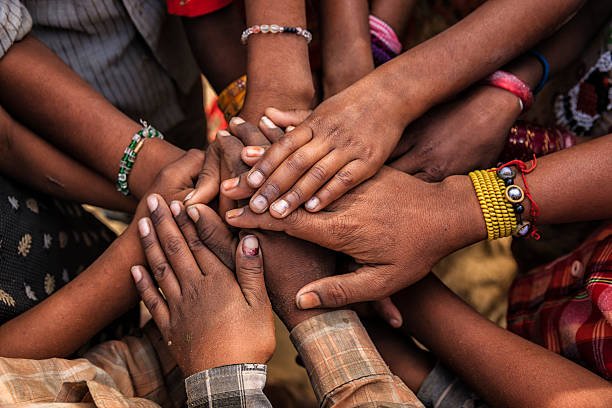Source: Africapublicity
In the heart of Africa, where the savannah meets the rolling hills, lies the village of Nyamira. Known for its vibrant culture and resilient people, Nyamira was a place where tradition and innovation coexisted harmoniously. Here, nestled among baobab trees and beside the shimmering Lake Victoria, lived a group of individuals known for their ingenuity and teamwork.
Among them were four friends: Amina, a talented potter; Kwame, a skilled blacksmith; Zuri, a visionary farmer; and Jengo, a keen carpenter. Each was an expert in their craft, and together they formed a team known for pushing the boundaries of what was possible in their village.
One hot afternoon, as the sun cast long shadows over Nyamira, a challenge presented itself. The village council had announced that they would host the annual regional festival, an event that drew people from all over Africa. This year’s festival would focus on showcasing innovative solutions to common problems faced by rural communities. The council hoped that the event would inspire other villages to adopt creative solutions to their challenges.
The friends saw this as an opportunity to demonstrate their collective skills and creativity. They gathered in their usual meeting spot, a large wooden table under the shade of a great baobab tree. They began discussing ideas on how they could contribute to the festival.
Amina suggested creating a new type of pottery that could be used for multiple purposes, such as cooking, storing water, and even as a plant pot. Kwame thought about designing a tool that could improve farming efficiency. Zuri proposed developing an irrigation system that could work with the village’s limited water supply. Jengo envisioned building a multifunctional structure that could serve as both a community center and a marketplace.
As they brainstormed, it became clear that they needed to combine their ideas into a single, cohesive project. They decided to build an innovative community hub that would incorporate elements of Amina’s pottery, Kwame’s tools, Zuri’s irrigation system, and Jengo’s carpentry.
The next step was to develop a plan. They divided the tasks according to their expertise. Amina worked on designing the pottery, Kwame started crafting tools that would be used in the construction, Zuri planned the irrigation system, and Jengo drew up the blueprints for the community hub.
However, the project faced immediate challenges. The village lacked some of the materials needed for their ambitious plan, and not everyone was immediately on board with the new ideas. Tradition held a strong influence, and some villagers were skeptical of the changes proposed by the young innovators.
Amina organized community meetings to explain the benefits of their project. She demonstrated how her multipurpose pottery could simplify daily chores, making them more efficient and less labor-intensive. Kwame showcased his tools, explaining how they could make farming easier and more productive. Zuri presented his irrigation system, which could significantly improve crop yields despite the unpredictable rainfall. Jengo invited villagers to see the plans for the community hub, which would provide a space for gatherings, markets, and cultural events.
Gradually, the villagers began to see the potential of the project. The team’s dedication and clear explanations won over many skeptics. The council approved the project, and construction began in earnest.
The community hub took shape over the following months. Jengo and his team of carpenters worked tirelessly, using Kwame’s tools to build the structure. Amina’s pottery was incorporated into the design, with decorative elements and functional pieces integrated into the hub. Zuri’s irrigation system was set up to ensure the surrounding fields could benefit from a reliable water source.
As the project neared completion, the excitement in Nyamira was palpable. The festival was just around the corner, and the community hub was ready to be unveiled. The friends worked together to ensure everything was in place, from the irrigation system’s functionality to the pottery displays.
On the day of the festival, the hub stood proudly at the center of Nyamira, a testament to the power of teamwork and innovation. The festival attracted visitors from neighboring villages and beyond. The community hub was a hit, drawing praise for its multifunctional design and the innovative solutions it offered.
Visitors marveled at Amina’s pottery, which proved to be as versatile as promised. Kwame’s tools were demonstrated, showing how they made farming tasks more manageable. Zuri’s irrigation system was showcased in action, visibly improving the health of the crops. Jengo’s building served as a lively marketplace and gathering space, filled with music, dance, and storytelling.
The success of the festival marked a turning point for Nyamira. The innovative solutions presented by Amina, Kwame, Zuri, and Jengo inspired other villages to explore creative approaches to their own challenges. The community hub became a model for blending traditional craftsmanship with modern technology, proving that progress could be achieved while respecting cultural heritage.
In the end, the project was more than just a display of ingenuity; it was a testament to the strength of teamwork and the impact of innovation. Amina, Kwame, Zuri, and Jengo had shown that when diverse talents come together, they can overcome obstacles and create something truly transformative.
The village of Nyamira continued to thrive, with its new community hub standing as a symbol of what could be achieved when people worked together with a shared vision. The festival became an annual event, celebrating creativity and collaboration, and inspiring many more villages across Africa to embrace the power of teamwork and innovation.
And so, under the shade of the great baobab tree, where it all began, Amina, Kwame, Zuri, and Jengo gathered once more. Their shared success had forged not only a remarkable project but also an enduring bond of friendship and mutual respect. As they looked toward the future, they knew that their journey was just beginning, and that with continued collaboration and creativity, there were no limits to what they could achieve.








